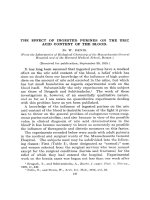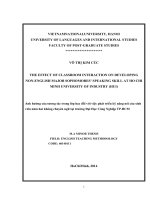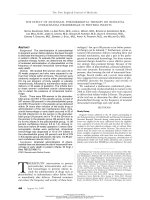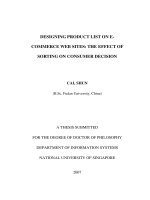Designing product list on e commerce web sites the effect of sorting on consumer decision
Bạn đang xem bản rút gọn của tài liệu. Xem và tải ngay bản đầy đủ của tài liệu tại đây (1.45 MB, 156 trang )
DESIGNING PRODUCT LIST ON E-
COMMERCE WEB SITES: THE EFFECT OF
SORTING ON CONSUMER DECISION
CAI, SHUN
(B.Sc. Fudan University, China)
A THESIS SUBMITTED
FOR THE DEGREE OF DOCTOR OF PHILOSOPHY
DEPARTMENT OF INFORMATION SYSTEMS
NATIONAL UNIVERSITY OF SINGAPORE
2007
Acknowledgements
First of all, I want to express my deepest gratitude to my supervisor, Dr. Xu Yunjie,
for his advice and guidance throughout the duration of this thesis. You have
provided me with your invaluable guidance and support over five years in the
preparation of this manuscript and encouragement throughout what has been most
enjoyable years of study. Dr. Xu, thank you especially for your enthusiasm,
constant support, and expert advice. Writing this dissertation has been a long-
standing goal, which without your help I would still be struggling with. Your
involvement has indeed been highly instrumental to the completion of my Ph.D. I
am indebted to you, for without your encouragement, supervision and guidance I
would not be in this position that I am today.
I would also like to take this opportunity to thank Associate Professor Teo Hock
Hai and Dr. Kim Hee-Wong for their guidance and caring in my research during
my study in NUS. They gave interesting and useful suggestions for carrying out
this piece of research work. I thank the Department of Information Systems of
NUS for giving me an opportunity to study in Singapore, as well as financial
support. Furthermore, I would like to thank Madam Loo Line Fong in SoC
Graduate Office who is always patient with my iterative questions and troubles.
I am also grateful to all my good friends I met in Singapore. It is my pleasure to
meet you here and the happy days spent with you really made my PhD life more
colourful.
ii
To my beloved parents, Cai Xiongpeng and Jiang Peiyu, I would like to express
my earnest thanks to them for providing me the psychological and emotional
support, in the most challenging times. To my wife, Cao Yue, I would like to say
thank you for your forbearance and support during the many months I spent
working on this thesis. You’ve always provided me with support when I needed
you. This thesis would not have been possible without your continuous support
and encouragement. Also, to my daughter, Cai Mengtong who has come to this
world for 19 days, you are the best gift ever in my life.
Cai Shun
December 2007
iii
Table of Content
Acknowledgements ii
Table of Content iv
Summary vi
List of Figures ix
List of Tables x
Chapter 1 Introduction 1
1.1 Introduction 1
1.2 Product List Design on Electronic Shopping Sites 3
1.3 Limitations of Current Literature 6
1.4 Research Purposes & Scope 10
1.5 Research Contributions 13
1.6 Thesis Organization 14
Chapter 2 Literature Review 17
2.1 Overview 17
2.2 Information Display and Decision Making 17
2.3 Ordering Effect 21
2.3.1 Empirical Evidences of Ordering Effect 21
2.3.2 Mechanisms of Ordering Effect 23
2.4 Information Processing Cost Effect 25
2.4.1 Empirical Evidences of Information Processing Cost Effect 26
2.4.2 Mechanism of Information Processing Cost Effects: Principle of
Concreteness 29
2.5 Order Effect 30
2.5.1 General Order Effects 31
2.5.2 Mechanisms of Order Effects 33
2.5.3 Serial position Effect 37
2.5.4 Direction of Comparison Effect 39
2.6 Summary of Literature Review 41
Chapter 3 Research Model and Hypotheses 43
3.1 Overview 43
3.2 Consideration Set Formation 45
3.3 Quality Importance and Price Importance in Decision Making 47
3.3.1 Quality/Price Importance and Product Choice 47
3.3.2 Antecedents of Attribute Importance 50
3.4 Sorted List versus Unsorted List 55
3.5 Descending List vs. Ascending List 58
3.6 Serial position Effect 61
3.7 Summary of Hypotheses 63
Chapter 4 Research Methodology 65
4.1 Overview 65
4.2 Pre-Test 66
4.2.1 Pre-Test Design 66
4.2.2 Pre-Test Results 67
4.3 Main Study 69
4.3.1 Participants and Incentives 69
iv
4.3.2 The Experimental System 69
4.3.3 Independent Variable 72
4.3.4 Dependent Variables 73
4.3.5 Procedure 75
Chapter 5 Data Analysis 77
5.1 Overview 77
5.2 Demographics 77
5.3 Manipulation and Control Checks 78
5.4 Hypotheses Testing 81
5.4.1 Sorting Effects on QI, PI, and RIQP 81
5.4.2 Sorting Effects on Consideration Set Formation 88
Chapter 6 Discussions 94
6.1 Overview 94
6.2 Discussion of Sorting Effects: Comparing Ascending List with Random List
94
6.2 Discussion of Sorting Effects: Comparing Descending List with Ascending
List 97
6.3 Control: Serial position Effect 99
Chapter 7 Conclusions and Implications 100
7.1 Overview 100
7.2 Theoretical Implications 100
7.3 Practical Implications 101
7.3 Limitations & Future Research 102
Reference List 105
Appendixes 133
Appendix A: Pre-test Questionnaire 133
A-1 Ranking Digital Camera Quality Attributes 133
A-2 Digital Cameras Overall Quality Rating 135
Appendix B: Main Study Questionnaire 137
B-1 Personal Information 137
B-2 Experimental Website 139
B-3 Product Selection 139
B-4 Post-Experiment Questions – Section I 140
B-5 Post-Experiment Questions – Section II 141
Appendix C: Screen Captures of Product List Display on Current Electronic
Shopping Sites 143
v
Summary
One revolutionary power of the online environments is that the display of
information is very malleable, and under the control of the seller, buyer, or both
(West et al. 1999). Against the background of the rapid growth of business-to-
consumer electronic commerce, it becomes increasingly important to develop an
understanding of how consumers process product information and make purchase
decisions in digital marketplaces.
One common information display design which appears in nearly all the electronic
shopping sites is the product list on e-commerce websites, where a number of
products are displayed together to allow online consumers to search for and
choose from. This product list may be the results from simple keyword searches or
alphabetic listing (Diehl2005), occur naturally because of heterogeneity in
consumer attribute weights (Diehl et al. 2003), exist because Web site arranges
options in the form of a list with the first item representing the most desired option
(Tam et al. 2005), or appear as the searching results from online recommendation
agents (Haubl and Murray 2003).
This product list can appear in several ways. Taking online vendors who sell
digital cameras online as examples, some of them allow consumers to sort
products by various product attributes in both a descending order or an ascending
order, as freely as consumers want (e.g. www.ecost.com); some provide
consumers with sorting tools but only allow them to sort the products in either a
descending order (e.g. www.circuitcity.com) or in an ascending order
vi
(e.g. www.dbuys.com); there are also some other vendors who do not provide any
sorting tools but present the product list in a alphabetic order of brand or model,
which results in a somewhat random list in terms of product quality
(e.g. www.bestbuy.com). Given that consumer’s preference is often ill-defined,
unstable and particularly susceptible to information format in which the products
are presented (Bettman et al. 1998), if the design of product list as a specific type
of information format could be a potential determinant of consumer choice (Hong
et al. 2004), what will consumers response to the listed alternatives and select a
particular offer? Will the design of product list, in particular, a descending list, an
ascending list or a random list (in terms of certain product attributes), influence
consumer choice?
There are extensive evidences from Information Systems (IS) literature (e.g.
Benbasat and Dexter 1986; Hong et al. 2004), marketing literature (e.g. Diehl et
al. 2003; Lynch and Ariely 2000), and psychology literature (e.g. Bettman et al.
1986; Kleinmuntz et al. 1993) show that the same information presented in
different formats can result in different purchase decisions. However, the extant
literature has not been particularly insightful on how consumers respond to
different order of product list. Despite the intuitive postulation that items
appearing in an early position of a list may draw more attentions from consumers
(serial position effect), it is not evident whether and how different order of
products in a list affect consumer decisions.
Drawing upon a number of theories from information systems, decision science
and economics, this thesis manifests an effort to understand the role of sorted
vii
product list on consumer decision making. The purpose of this research is to
investigate how product list design (ascending list, descending list, and random
list) influence consumers’ perceptions on product quality and price importance as
well as their consideration set formation. Specifically, we investigated consumers’
decision making when they were exposed to three types of product lists, which
were created as results of product sorting by quality in three different orders.
Results from a carefully designed experiment showed that three product sorting
orders (ascending, descending, and random) directly influenced consumers
perceptions on importance of product quality and price, given that product quality
and price are typically correlated. Further, product sorting was found to
significantly affect the possibility of products being included in consumers’
consideration set in product choice. In general, consumers are more likely to
include products with higher quality and price in their consideration sets when
they are exposed to a descending sorted product list.
Such investigations are important because the design of product listing pages
explains more than half of the variance in monthly sales on commercial Web sites
(Lohse et al. 1998). Although relatively unordered environments still dominate
online, personalization and customization technologies are among the most
promising and imminent developments explored by both online marketers and
researchers (Diehl2005; Tam et al. 2005). Accounting for the sorting effect in
models that predict online consumer’s preference and choice can enable marketers
to construct strategically product list driven by business objectives.
viii
List of Figures
Figure 1. Comparison of Profit Levers…………………. ………………… 3
Figure 2. Summary of Literature Review…………………. ……………… 42
Figure 3. Research Framework…………………. …………………………. 44
Figure 4. Research Model – Sorting Effects…………………. …………… 45
Figure 5. Screen Capture of the Product List Page…………….…………… 72
Figure 6. Screen Capture of the Detailed Product Information Page……… 73
Figure 7. Illustration of Means of QI & PI in Three Groups………………… 83
Figure 8. Illustration of Means of RIQP in Three Groups…………………. 84
Figure 9. Illustration of HLM Hypotheses Testing Results …………. …… 94
Figure 10. Web Site - No Sorting Function…………………. ……………… 143
Figure 11. Web Site - Price Sorting…………………. ……………………… 143
Figure 12. Web Site – Sorting on Quality Attributes…………………. …… 144
Figure 13. Web Site – Sorting on Customer Rating & Popularity…………… 144
Figure 14. Web Site – Sorting on Popularity…………………. ……………… 145
ix
List of Tables
Table 1. Summary of Literatures on Ordering Effects………………………… 23
Table 2. Summary of Literatures on Information Processing Cost
Effects………………………………………………………………… 25
Table 3. Summary of Literatures on Order Effects……………………… ……. 32
Table 4. Antecedents of Quality and Price Importance (Sensitivity) ………… 50
Table 5. Summary of Hypotheses……………………………………………… 65
Table 6. Ratings on Overall Product Quality…………………………………… 69
Table 7. Subject Assignment in Product Sorting Experiment…………………. 70
Table 8 Measurement for Dependent Variables……………………………… 75
Table 9. Descriptive Analysis - Demographics………………………………… 79
Table 10. Manipulation Check – Consumer Recognition of Product
Order……………………………………………………………… 80
Table 11. Post-hoc Analysis Presented by Mean Difference between
Groups…………………………………………………… ………… 80
Table 12. Random Assignment Check…………………………………… …… 81
Table 13. Means and Standard Deviation of QI, PI &
RIQP…………………………………………………………. ……… 82
Table 14. Turkey’s Post Hoc Test Results……………………………… ………. 84
Table 15. Summary Hypotheses Testing on QI, PI & RIQP…………………… 87
x
xi
Table 16. HLM Analysis Equations……………………………………………… 90
Table 17. Two Dummy Variables Representing Three Sorting
Conditions……………………………………………………………… 91
Table 18. HLM Results on Hypotheses Testing………………………………… 92
Chapter 1 Introduction
1.1 Introduction
Despite its newness, e-commerce is revolutionizing many aspects of the
transactions between consumers and firms (Hoffman 2000). The Internet has
dramatically democratized direct networked access to vendors, putting them only
a few mouse-clicks away from consumers. This revolution has resulted in a need
to understand consumer behaviour online and how consumers interact with e-
commerce Web sites because of the enormous impact from the use of IT and its
consequential impact on market success (Straub and Watson 2001).
As a new marketing channel, the Internet differs from the traditional retail formats
in many ways (Alba et al. 1997; Butler and Peppard 1998; Childers et al. 2001;
Jiang and Benbasat 2004; Koufaris 2002). A unique characteristic of online
shopping is that consumers evaluate products and make judgments based on the
product information presented on web pages (e.g. Hong et al. 2004; Tam et al.
2005). Unlike traditional in-store shopping, where shopping information is
conveyed to consumers through multiple channels, including the displays of
products, store environment, and service (Schiffman et al. 1977), B2C e-
commerce depends solely on Web interface to communicate such information.
The rapid growth in e-commerce and the distinctiveness of this new marketing
channel highlight the importance of understanding how consumers make decisions
1
in electronic shopping environments (Hong et al. 2004; Hong et al. 2005). From
an online marketer’s perspective, designing effective Web sites requires an
understanding of how online consumers react to Web site designs (Song and
Zahedi 2005). To a large extent, the promise of online shopping dependents on the
design of Web interfaces and the way consumers interact with Web sites (Hoque
and Lohse 1999).
With e-commerce growing steadily, online vendors are embracing the advantages
of dynamic interface design to keep shoppers happy – and spending. According to
Marn and Rosiello (1992), for a company with average economics, improving unit
volume by 1% yields a 3.3% increase in operating profit, assuming no decrease in
price. But, a 1% percent improvement in price, assuming no loss of volume,
increases operating profit by 11.1%. Improvements in price typically have three to
four times the effect on profitability as proportionate increase in volume (see
Figure 1). Therefore, from an online vendor’s perspective, how to make
consumers spend more is critical to its profitability and bottom-line competition in
the crowded electronic market. Despite many marketing strategies to encourage
consumers to buy a larger quantity of products, encouraging consumers to shop
for “premium” or high-end products also significantly contributes to the
profitability. Ceteris paribus, high-end products often bring in more profits for
both retailers and manufacturers. A story in Business Week reported how Samsung
achieved significant profit increase in China market a few years ago. According to
Ihlwan and Roberts (2002), China used to be the shortcut to hell for ambitious
managers at Samsung since they pushed entire product lines to China market.
However, soon after the new CEO took the position, Samsung’s marketing
2
strategy was revised by concentrating on top-of-the-line electronic products.
Those high-end products gained more profits for Samsung itself as well as its
dealers and the profits soared 70% for the year of strategy changed. In e-
commerce, how to encourage consumers to shop for products with higher quality
could be a desirable technique for online vendors. Our study, therefore, attempt to
demonstrate that, carefully designing a product list in certain ways can help online
vendors to achieve this goal.
1% Improvement in … Æ…Creates Operating Profit Improvement of
11.10%
7.80%
3.30%
2.30%
0.00% 2.00% 4.00% 6.00% 8.00% 10.00% 12.00%
Price
Variable Cost
Volume
Fixed Cost
* Based on average economics of 2,463 companies in Compustat aggregate
Figure 1. Comparison of Profit Levers
1.2 Product List Design on Electronic Shopping
Sites
One common information display design which appears in nearly all the electronic
3
shopping sites is the product list on online vendors’ Web sites, where a number of
products are displayed together to allow online consumers to search for and
choose from products (Diehl et al. 2005). This product list may be the results from
simple keyword searches or alphabetic listing (Diehl2005), occur naturally
because of heterogeneity in consumer attribute weights (Diehl et al. 2003), exist
because Web site arranges options in the form of a list with the first item
representing the most desired option (Tam et al. 2005), or appear as the results of
search in online recommendation agents (Haubl and Murry 2003). Electronic
shopping sites often organize product list in a tabular form, with each row
corresponding to an alternative and each column to an attribute on which the
alternative is described (Kleinmuntz et al. 1993). Publications like consumer
reports use this organization for product comparisons.
One way to encourage consumers to select high-quality products is increasing
consumers’ perception on quality importance or reducing their price importance or
sensitivity in judgment and choice. This could be achieved by making product
quality information easier to search and process (Lynch and Ariely 2000).
Providing a product list sorted based on quality is one method to make quality
information more processable. However, many electronic shopping sites fail to
provide adequate function on quality sorting. Some Web sites do not provide any
sorting function (see Appendix C-1), while some only provide functions which
allow consumers to sort products by price, not quality (see Appendix C-2). Among
those Web sits which provide sorting functions related to product quality, they
allow consumers to either sort by brand or manufacturer, by customer ratings on
quality or by popularity (see Appendix C for examples). However, consumers
4
often do not fully trust the customer ratings on electronic shopping sites because
they do not know whether those ratings truly come from real customer evaluations
and consumers often have own evaluations significantly different from other
consumers who rated the products. In addition, the popularity rating is not a good
indicator of product quality because a “star buy” model does not mean it has high
quality (configuration). Some electronic shopping sites could generate
personalized product recommendations in the form of a list in which alternatives
can be sorted by most of the key attributes of products (e.g. Yahoo! Shopping Site,
Appendix C). However, although consumers are allowed to select the most
important quality attribute for them by which products are sorted, a single quality
attribute can not adequately represent the overall quality. In sum, sorting functions
mentioned above might not sufficiently increase consumer’s perceived quality
importance. In this study, we propose that products can be sorted by quality
attributes in a hierarchical way, in which products are first sorted by the most
important attribute perceived by consumers, and then the second most important
attribute, etc. It is conjectured that the hierarchical sorted list by quality might be a
close representation of product overall quality levels and can be easily recognized
by consumers. We expect hierarchical sorted list by quality could increase the
quality importance in consumer judgment and choice and thus encourage them to
shop for products with higher quality level.
If this kind of sorted list does affect consumer decision making, the next question
is: should we sort product list in an ascending way or descending way? Some
electronic shopping sites allow consumers to sort products by various product
attributes in both a descending order or an ascending order, as freely as consumers
5
want (e.g. www.ecost.com); some others provide consumers with sorting tools but
only allow them to sort the products in either a descending order
(e.g. www.circuitcity.com) or in an ascending order
(e.g. www.dbuys.com, www.jr.com); there are also some other e-tailers who do
not provide any sorting tools but present the product list in a alphabetic order of
brand or model, which results in a somewhat random list in terms of product
quality (e.g. www.bestbuy.com
, www.buy.com). Given that consumer’s preference
is often ill-defined, unstable and particularly susceptible to information format in
which the products are presented (Bettman et al. 1998), if the design of product
list as a specific type of information format could be a potential determinant of
consumer choice (Hong et al. 2004), what will consumers response to the listed
alternatives and select a particular offer? Will the design of product list, in
particular, a descending list, an ascending list or a random list (in terms of certain
product attributes), influence consumer choice?
1.3 Limitations of Current Literature
Many traditional models of consumer choice assume that a consumer’s tastes are
well articulated, and much likes psychophysical functions. A more recent evolving
view started from about three decades ago suggests that for some kinds of
preference, consumers are often constructing their preference on the sport and
adapt their decision making strategies to specific situations and environments
(Hoeffler and Ariely 1999). In electronic shopping context, consumers’ purchase
decision is likely to be affected by online environments due to electronic shopping
site’s ability to manipulate the context in which the choice is made (Mandel et al.
6
2002). Consumer choice, whether in a physical or electronic environment, seems
increasingly to be jointly determined by both a consumer’s preference and the
features of the shopping environment (West et al. 1999).
One revolutionary power of the online environment is that the display of
information is very malleable, and under the control of the seller, buyer, or both
(West et al. 1999). There are extensive evidences from Information Systems (IS)
literature (e.g. Benbasat and Todd 1985; Benbasat and Dexter 1986; Hong et al.
2004), marketing literature (e.g. Diehl et al. 2003; Lynch et al. 2000), and
psychology literature (e.g. Bettman et al. 1986; Kleinmuntz et al. 1993) show that
the same information presented in different formats can result in different
decisions.
According to Bettman et al. (1986), there are three potential benefits associated
with providing product information in certain format: improved decision making,
reduced prices and enhanced product quality. Overlooked in all work to date on
the effects from information format on decision making is the fact that those
studies have largely focused on the effects on consumers’ decision quality (Diehl
2005; Haubl and Trifts 2000; Speier and Morris 2003) and price (Garbarino and
Slonim 1995; Kosenko 1989; Lynch et al. 2000; Russo 1977). Despite the
intuitive plausibility of the notion that making quality information more
processable should increase the quality importance, there have been few studies
demonstrating the effects of information format on decision criteria: especially the
importance of product quality. Given that consumers typically perceive product
quality and price as correlated (Cha and Aggarwal 2003), and that manipulations
7
of information format could simultaneously influence consumers’ perceptions on
both product quality and price, ignoring the role of quality might reduce the value
of theories in explaining consumer choice behaviours.
The effects of different design of product list on consumer decision making and
choice are particularly difficult to understand because the arrangement of product
list could produce several different effects simultaneously and those effects may
compound each other in influencing decision making. Those effects consist of
ordering effect, information processing cost effect, and serial position effect (order
effect). Although the focus of this study is more on the first two effects, the third
effect, that is, serial position effect, is also briefly reviewed since sorting product
list unavoidably change the positions of products in a list and thus bring in serial
position effect. We also test the serial position effect in this study for the control
purpose.
The first effect is ordering effect, which refers to the effects from arranging the
positions of all the products in a list by certain product attributes (e.g. price,
configuration) based on certain rules (e.g. descending, ascending). Unavoidably,
ordering products not only change the positions of each individual items in a list
(order/serial position effect), but also the overall trend of a list of products. For
example, online vendors often arrange the products based on their prices. As we
compare the two effects discussed above, we can see order effect/serial position
effect could be a by-product of ordering effect. For the clarity of our discussion,
the ordering effect discussed in this study only focus on the effects from arranging
products based on certain rule (e.g. ascending, descending) but not include
8
order/serial position effect. Studies on ordering effect in E-commerce are almost
scant. Among the few exceptions including the analysis of ordering effects (e.g.
Diehl et al. 2003; Diehl2005), they did not differentiate order/serial position
effects from ordering effect. Thus, their results could be confounded by serial
position effect. For example, if subjects selected a higher quality option from a
ordered (declining on quality) list, this result could be attributed to either changes
in subjects’ perceptions on quality importance, or changes in attentions of subjects
being drawn to the upper list of the options. Further investigations are needed to
systematically examine ordering effect while not ignoring the serial position
effect.
The second effect is information processing cost effect. The design of product list
could have a potential influence on how consumers compare product attribute
information and make decision. For example, Lynch and Ariely (2000)
systematically vary the design of online stores to alter information search costs.
When the online retail store design made quality information easier to search and
compare, respondents became less price sensitive. Haubl and Murray (2003)
found that when a product attribute was included in a comparison matrix of
recommendation agents, this attribute become more processable when respondents
compare products and hence more prominent in consumers’ purchase decision.
However, although several studies have shown that changes of information search
costs might affect how consumers compare product attributes and hence their final
choice, whether solely sorting products by certain attributes could lead to this
effect remains unknown.
9
The third effect related to product list is serial position effect, which generally
refers to the effect from the position of one product in a list on the chance of this
product being attended, memorized, recalled, short listed, or finally selected. This
effect has a long tradition of being studied in psychology literature and termed
“order effect” generally. In E-commerce literature, this effect has also been
observed and recognized and termed “serial position effect”. For example, in
comparison shopping, previous studies showed that vendor’s serial position in a
comparison list was found to be a significant none-price factor affecting consumer
choice such that vendors listed in the first screen or the first position of a list
enjoyed a significant advantage (Smith and Brynjolfsson 2001). Meanwhile, paid
inclusion and paid placement in search result of search engines is increasingly a
common practice in internet marketing. Although this effect is relatively well
understood, it could confound with the second effect, namely, ordering effect, and
make it difficult to explain effects from product list design on decision making.
1.4 Research Purposes & Scope
The purpose of this study is to enhance our understanding of the effects of sorting
product list by product quality on consumer decision making and its effectiveness
in influencing consumer choice behaviour. Specifically, we attempt to answer the
following research questions: 1) how does sorting products by product quality in
different ways (ascending, descending, and random) affect consumer choice from
a list of products? We suggest that sorting products by quality in certain ways will
affect consumers’ perceptions on importance of product quality and relative
importance of quality over price, and the changes in the importance perceptions
10
will in turn influence consumer choice. 2) Why sorting products by product
quality in different ways could lead to changes in importance perceptions and
choice? We will explain this phenomenon based on theories and empirical
evidences from IS, psychology, and economics literatures. We term the overall
effects from sorting products by quality in three different ways as “sorting effect”.
It is an overachieving concept subsumes order/serial position effect, ordering
effect, and information processing cost effect.
Although many studies have investigated online shopping behaviour from a
consumer’s perspective, which largely focused on how to attract consumers to
online stores and how to gain their satisfaction and loyalty, we approach this issue
from an online retailer’s perspective and focus on how to design a product list in
order to influence consumer’s behaviour. Designers of commercial web sites face
a myriad of decisions about how to organize the present product information,
often without knowing how their design influences consumers’ decision making
processes and subsequent choice. The goal of this research is to investigate how
product list design (ascending list, descending list, and random) influence
consumers’ purchase decisions. In this study, product quality attributes refers to
the technical specifications of a product’s non-price attributes. Taking digital
camera as an example, megapixl, optical zoom are important quality attributes of a
digital camera. Product quality is the combination of all those attributes, i.e., the
overall configuration of the product. Accordingly, the perceived product quality
refers to consumers’ subjective evaluation of the overall excellence of the product
quality. Further, in line with previous research, the quality importance (QI) (price
importance (PI)) refers to the importance of product quality (product price) in
11
influencing purchase decisions (cf. Kalra and Goodstein 1998). Accordingly, the
relative importance of quality over price (RIQP) refers to relative importance
weights attached to product quality over price when consumers make the purchase
decisions. RIQP might be the result of QI divided by PI.
This study includes a pre-test via survey and a main study via laboratory
experiment. The pre-test survey serves two purposes: 1) to identify the important
product attributes and the sequence in terms of importance level. This procedure
enables us to design sorted product list which can best represent products’ overall
quality levels. 2) To provide subjective overall quality ratings of each products in
the main study. The main study was carried out via a carefully designed laboratory
experiment. An experimental electronic shopping Web site was developed with
ASP.NET to manipulate the three product list order and simulate a typical online
shopping task. A following questionnaire was distributed to all participants to
measure their decision outcomes.
After reporting demographics information and carefully checking manipulation
and controls, a series of ANOVAs were conducted to test participants’ responses
on quality importance, price importance, and relative importance of product
quality over price. After that, a hierarchical linear model (HLM) method was
employed to test the effects of product sorting on consumer’s consideration set
formation.
Such investigations are important because the design of product listing pages
explains more than half of the variance in monthly sales on commercial Web sites
12
(Lohse et al. 1998). Although relatively unordered environments still dominate
online, personalization and customization technologies are among the most
promising and imminent developments explored by both online marketers and
researchers (Diehl2005; Tam et al. 2005). Accounting for the sorting effect in
models that predict online consumer’s preference and choice can enable marketers
to construct strategically product list driven by business objectives.
1.5 Research Contributions
This thesis seeks to contribute and benefit to both theoretical and practical arenas.
From theoretical perspective, it can potentially contribute to the existing literature
on consumer decision making in electronic shopping in Human-Computer
Interaction and E-Commerce literature.
z It demonstrates that consumer decision making in electronic shopping
environments might be influenced by the information format of presentation,
and product list design as one specific type of information format could affect
consumer choice.
z Building on the theories from decision science and economics literature, we
explain how product sorting affects consumer choice of products from a list.
In particular, we demonstrates that consumers’ perceptions on quality
importance, price importance, and relative importance of quality over price
might be affected by product sorting, and these changes in importance
perceptions will in turn lead to changes in consumer formation of
13
consideration set.
z Based on an extensive review of order effects, ordering effects, and
information processing cost effects, we integrate theories from psychology,
marketing, and economics, our study complements the current research by
examining the differences between ascending order list and descending order
list. Our finding suggests that a ‘loss aversion’ situation can be created on a
webpage by properly arranging product orders in a list.
From a practical perspective, this study has implications for online vendors and
marketers on how to construct strategically product list driven by business
objectives. Our findings suggest that providing consumers with a descending list
of products based on product quality could make consumers more quality (quality)
sensitive. Applying the finding, electronic shopping sites can easily increase the
attractiveness and purchase likelihood of designated options. For example, if used
appropriately, they can “implicitly” promote high quality items when high-quality
items are more profitable by designing a descending list of products, or vice versa.
Because the presentation order has the advantage of being easily controllable by
online vendors, this consequence has immediate practical implications.
1.6 Thesis Organization
This thesis comprises seven chapters.
Chapter 1 introduces the problems in product list design in terms of sorting and
14









